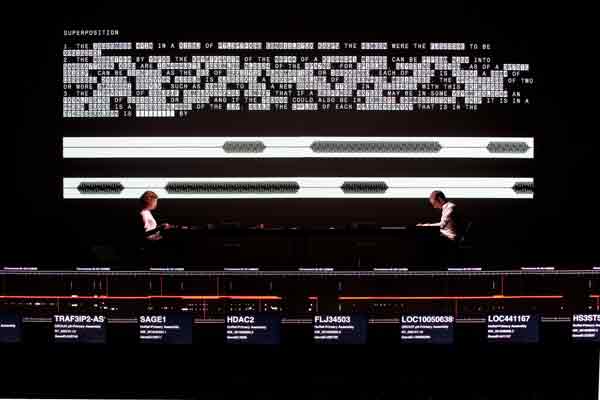Renowned visual artist and electronic composer Ryoji Ikeda brings his Australian premiere of ‘Superposition’ to the OzAsia Festival this September.
Described as an immersive digital and live performance experience, Ikeda is inspired by the mathematical notions of quantum mechanics. ‘Superposition’ fuses art and science with synchronised video screens, real-time content feeds, digital sound sculptures, and even includes two human performers in the mix.
Using live performers for the first time, Ikeda will have them generate movement and sound onstage, translating to visual elements like words, numbers and type-written phrases. The stage will consist of 21 screens, precisely coordinated to display the graphical materials generated live.

Ryoji Ikeda’s <<numerical>> image.
The work was originally commissioned for Festival d’Automme a Paris where it’s initial development was presented in 2012. Now co-presented by OzAsia Festival and Carriageworks in Sydney, 'Superposition' will premiere in Australia this year.
In 2013, Ryoji Ikeda’s light installation ‘Spectra’ featured at Dark Mofo in Hobart, and his vast, audio-visual installation ‘Test Pattern [No.5]’ was presented in Sydney. It attracted great success and audiences were enthralled by it’s interactive nature and the overwhelming sensory experience of work.

So ‘Superposition’ is about how the language of information correlates to nature? How do you describe this connection?
Since Galileo stated 400 years ago as follows, we human have to decipher the mathematical language of nature to understand nature itself, which is the very basis of modern science.
“Philosophy [nature] is written in that great book which ever is before our eyes – I mean the universe – but we cannot understand it if we do not first learn the language and grasp the symbols in which it is written. The book is written in mathematical language, and the symbols are triangles, circles and other geometrical figures, without whose help it is impossible to comprehend a single word of it; without which one wanders in vain through a dark labyrinth.”
It has been working for many years to describe Nature quite well —from behaviours of matter around us to our planetary orbit.However, when we try to understand Nature at very small scale —under atomic (sub-atomic) scale, the mathematical language of Nature becomes rather uncertain; so-called 'quantum state'. In the quantum state, we only can obtain single information, we cannot contain more than two parameters at the same time such as the position of electron and the speed of that. In such a small scale, our observation towards sub-atomic entity disturbs the observation itself because light (photons) interfere our observation.
Nowadays, information is thought the language of Nature, and contemporary science is, in a sense, all about to understand how to handle information: the new language of Nature. To me, superposition is the key of our current understanding Nature which questions some philosophically profound issues, which motivates the art project itself.
You’ve used the term ‘quantum computing’ to describe the concepts behind your work. Can you explain this theory for the uninitiated? You clearly have an in-depth understanding of mathematical formulas. What is your background?
I am greatly inspired by natural science and the viewpoint of it towards Nature itself. But I am just an artist, not scientist nor mathematician. I have to emphasise that i have never 'illustrated' any theories or theorems and I don’t need to do that. My job is just to make works of art that are always 'questioning' through 'feeling' —instead of 'answering' through 'understanding (logic)' which is science.
You has an initial showing of this piece in France in 2012, how has the process developed for you over the last three years?
Developments: tones of artistic/ technical refinements and sophistications. A major update since the premiere was not to have an intermission!
What inspired you to use live performers for the first time in this work?
I used to work with choreographers, dancers, musical players a lot. But after being quite tired of working with them, I had been stopping working with performers for a decade. To me, it was a good pause to see how to rework with human on the stage and it worked well.
You presented work in Sydney and Hobart in the past, how do you find your work is received by Australian audiences?
Australian audiences are always happy and accepting to try new experiences, and it’s great to present new work to them.
Are you looking forward to coming to Adelaide and being part of OzAsia festival?
I am very excited to be performing at OzAsia Festival.
Ryoji Ikeda’s ‘Superposition’ plays OzAsia Festival, 29 & 20 September.
– written by Tessa Leon






